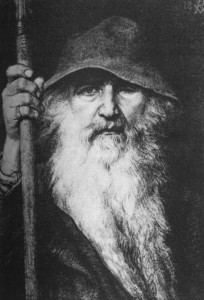Christmas and Santa: How the two came together
Santa Claus is the modern name for St. Nicholas, Sinter Klaas, Sankt Niklas, Father Christmas, Pere Noel, and many other ancient names. He is actually a combination of many beliefs and cultures all rolled up into one entity whom we now call “Santa Claus.”

(Photo via Wikipedia)
The most accepted origin for Santa Claus is St. Nicholas of Myra (which is now Turkey). He was a bishop in the fourth century who was very generous to both the poor and children.
There is an old story that talks of three young women whose family had no money, so they had no dowries, which were necessary for them to be married. The father was going to sell one of the daughters into slavery, so his other two daughters would have dowries.
St. Nicholas heard of this family’s situation and decided to help. The legend states that St. Nicholas threw three bags of gold down the chimney. The girls had their stockings hung by the fire to dry and somehow a bag of gold landed into each stocking. This gift gave each girl their much-needed dowries and allowed them to be married.
St. Nicholas lived a very humble life. He tried to help people as much as possible, tried to instill a desire in people to emulate his way of life. The legend of St. Nicholas and his goodness spread throughout Europe, Russia, and Greece. The kind-hearted St. Nicholas died on December 6, and this became his feast day. The medieval Christmas season started on December 6.
Children would put food and treats out for St. Nicholas on the eve of his feast day, and good little boys and girls would find sweets and toys for them in place of what they had left for St. Nicholas.

(Photo via Wikipedia)
St. Nicholas Day is still observed in several countries to this day including: Bulgaria, Austria, Ukraine, Italy, and many more.
The evolution of St. Nicholas to Santa Claus appears to have started back around the 16th century. At that time, the Protestant Reformation took place and believing in saints became something of a taboo. However, the reformists were not very successful in getting rid of St. Nicholas.
Most of the colonists who came to the new world were Reformists, so they did not bring any images of St. Nicholas. Instead, the Dutch are credited with bringing St. Nicholas to the Americas.
After the American Revolution, New Yorkers got in touch with their nearly lost Dutch roots. John Pintard, the founder of the New York Historical Society, named St. Nicholas as the patron saint of both the Historical Society and the city.
On December 6, 1810, John Pintard had an artist, Alexander Anderson, make a picture of the first American image of St. Nicholas. Anderson painted a picture of St. Nicholas giving gifts and putting candies and treats in stockings of children that were hung by a fireplace. There was an accompanying poem that ended with “Saint Nicholas, my dear good friend! To serve you ever was my end, If you will, now, me something give, I’ll serve you ever while I live.”
Later in 1923, a poem was printed that touted a “jolly elf image” called “A Visit From St. Nicholas.” Today we know that poem as the “Night Before Christmas.” There is some dispute as to who really wrote the poem: some think it was Washington Irving, others Clement Clark Moore, and some Henry Livingston. Regardless of who the author really was, this poem was instrumental in influencing the American version of St. Nicholas.
St. Nicholas took on several changes over the years in his appearance. In 1863, a political cartoonist, Thomas Nast, created a series of black and white drawings in “Harpers Weekly.” His version was a very large, round Santa with fur clothing, a long beard and a pipe.
Nast drew Santas until 1886. During that time, St. Nicholas had a little change in his name. It was a combination of the German “Sankt Niklaus” and the Dutch “Sinterklaas” — Santa Claus.

(Photo provided by author)
American artist Norman Rockwell forever etched his version of Santa in the minds of Americans on covers of the Saturday Evening Post.
Coca-Cola had an artist come up with their version of Santa Claus in 1931, and he spent 35 years showing that Coca-Cola was a beverage to drink any time of the year. Coke’s version of Santa was sent around the world, even to Europe where St. Nicholas was still the celebrated version of “Santa Claus.”
Since Christmas is a time to give to those less fortunate than we are, I think this history of St. Nicholas/Santa Claus helps clear up why “Santa” is associated with Christmas.

Theresa O’Keefe has over two decades of experience in a variety of real-world endeavors; some of these include her being an entrepreneur, a corporate America professional, and a massage therapist. Her work life is rich and varied: she has owned several businesses including a computer business, a mobile karaoke business, and is now looking into starting an online vintage clothing and accessory business. In her corporate America experience, she has worked with several Fortune 500 companies including Federal Express, Walt Disney Company, Automated Data Processing (ADP). Theresa has a degree as a Holistic Healing practitioner, and previously worked as a massage therapist for over 5 years with both private clients and day spas. Today, Theresa prefers the freedom of working from home. She works as a writer on multiple projects, and is developing several ideas for script projects. She lives in beautiful Southern California, in Orange County, with her boyfriend, whose love and support allow her to pursue her passions.


